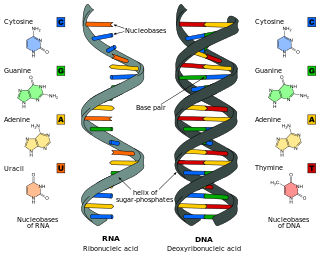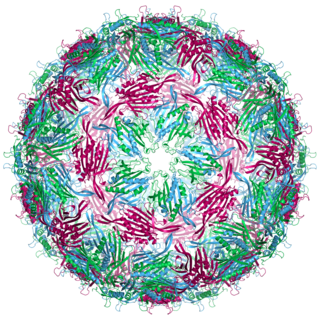Related Research Articles

Nucleic acids are large biomolecules that are crucial in all cells and viruses. They are composed of nucleotides, which are the monomer components: a 5-carbon sugar, a phosphate group and a nitrogenous base. The two main classes of nucleic acids are deoxyribonucleic acid (DNA) and ribonucleic acid (RNA). If the sugar is ribose, the polymer is RNA; if the sugar is deoxyribose, a variant of ribose, the polymer is DNA.

In genetics, a promoter is a sequence of DNA to which proteins bind to initiate transcription of a single RNA transcript from the DNA downstream of the promoter. The RNA transcript may encode a protein (mRNA), or can have a function in and of itself, such as tRNA or rRNA. Promoters are located near the transcription start sites of genes, upstream on the DNA . Promoters can be about 100–1000 base pairs long, the sequence of which is highly dependent on the gene and product of transcription, type or class of RNA polymerase recruited to the site, and species of organism.

Ribonucleic acid (RNA) is a polymeric molecule that is essential for most biological functions, either by performing the function itself or by forming a template for the production of proteins. RNA and deoxyribonucleic acid (DNA) are nucleic acids. The nucleic acids constitute one of the four major macromolecules essential for all known forms of life. RNA is assembled as a chain of nucleotides. Cellular organisms use messenger RNA (mRNA) to convey genetic information that directs synthesis of specific proteins. Many viruses encode their genetic information using an RNA genome.

In molecular biology, a stop codon is a codon that signals the termination of the translation process of the current protein. Most codons in messenger RNA correspond to the addition of an amino acid to a growing polypeptide chain, which may ultimately become a protein; stop codons signal the termination of this process by binding release factors, which cause the ribosomal subunits to disassociate, releasing the amino acid chain.

Frederick Sanger was a British biochemist who received the Nobel Prize in Chemistry twice.

Gene expression is the process by which information from a gene is used in the synthesis of a functional gene product that enables it to produce end products, proteins or non-coding RNA, and ultimately affect a phenotype. These products are often proteins, but in non-protein-coding genes such as transfer RNA (tRNA) and small nuclear RNA (snRNA), the product is a functional non-coding RNA. The process of gene expression is used by all known life—eukaryotes, prokaryotes, and utilized by viruses—to generate the macromolecular machinery for life.

Haemophilia B, also spelled hemophilia B, is a blood clotting disorder causing easy bruising and bleeding due to an inherited mutation of the gene for factor IX, and resulting in a deficiency of factor IX. It is less common than factor VIII deficiency.

In molecular biology, RNA polymerase, or more specifically DNA-directed/dependent RNA polymerase (DdRP), is an enzyme that catalyzes the chemical reactions that synthesize RNA from a DNA template.
Polyadenylation is the addition of a poly(A) tail to an RNA transcript, typically a messenger RNA (mRNA). The poly(A) tail consists of multiple adenosine monophosphates; in other words, it is a stretch of RNA that has only adenine bases. In eukaryotes, polyadenylation is part of the process that produces mature mRNA for translation. In many bacteria, the poly(A) tail promotes degradation of the mRNA. It, therefore, forms part of the larger process of gene expression.

Factor IX, also known as Christmas factor, is one of the serine proteases involved in coagulation; it belongs to peptidase family S1. Deficiency of this protein causes haemophilia B.

Ribosomal ribonucleic acid (rRNA) is a type of non-coding RNA which is the primary component of ribosomes, essential to all cells. rRNA is a ribozyme which carries out protein synthesis in ribosomes. Ribosomal RNA is transcribed from ribosomal DNA (rDNA) and then bound to ribosomal proteins to form small and large ribosome subunits. rRNA is the physical and mechanical factor of the ribosome that forces transfer RNA (tRNA) and messenger RNA (mRNA) to process and translate the latter into proteins. Ribosomal RNA is the predominant form of RNA found in most cells; it makes up about 80% of cellular RNA despite never being translated into proteins itself. Ribosomes are composed of approximately 60% rRNA and 40% ribosomal proteins, though this ratio differs between prokaryotes and eukaryotes.
In eukaryote cells, RNA polymerase III is a protein that transcribes DNA to synthesize 5S ribosomal RNA, tRNA, and other small RNAs.

In biology, the word gene has two meanings. The Mendelian gene is a basic unit of heredity. The molecular gene is a sequence of nucleotides in DNA that is transcribed to produce a functional RNA. There are two types of molecular genes: protein-coding genes and non-coding genes. During gene expression, DNA is first copied into RNA. RNA can be directly functional or be the intermediate template for the synthesis of a protein.

Factor VIII is a medication used to treat and prevent bleeding in people with hemophilia A and other causes of low factor VIII. Certain preparations may also be used in those with von Willebrand's disease. It is given by slow injection into a vein.

Biotechnology is the use of living organisms to develop useful products. Biotechnology is often used in pharmaceutical manufacturing. Notable examples include the use of bacteria to produce things such as insulin or human growth hormone. Other examples include the use of transgenic pigs for the creation of hemoglobin in use of humans.

Bacteriophage MS2, commonly called MS2, is an icosahedral, positive-sense single-stranded RNA virus that infects the bacterium Escherichia coli and other members of the Enterobacteriaceae. MS2 is a member of a family of closely related bacterial viruses that includes bacteriophage f2, bacteriophage Qβ, R17, and GA.

Elongation factor 1-beta is a protein that in humans is encoded by the EEF1B2 gene.

Cleavage and polyadenylation specificity factor subunit 4 is a protein that in humans is encoded by the CPSF4 gene.

Adolfo García-Sastre,(born in Burgos, 10 October 1964) is a Spanish professor of Medicine and Microbiology and co-director of the Global Health & Emerging Pathogens Institute at the Icahn School of Medicine at Mount Sinai in New York City. His research into the biology of influenza viruses has been at the forefront of medical advances in epidemiology.

Molecular cloning is a set of experimental methods in molecular biology that are used to assemble recombinant DNA molecules and to direct their replication within host organisms. The use of the word cloning refers to the fact that the method involves the replication of one molecule to produce a population of cells with identical DNA molecules. Molecular cloning generally uses DNA sequences from two different organisms: the species that is the source of the DNA to be cloned, and the species that will serve as the living host for replication of the recombinant DNA. Molecular cloning methods are central to many contemporary areas of modern biology and medicine.
References
- 1 2 3 4 5 "BROWNLEE, Prof. George Gow" . Who's Who . Vol. 2015 (online Oxford University Press ed.). A & C Black.(Subscription or UK public library membership required.)
- 1 2 Brownlee, G. G. (1979). "The Fourteenth Colworth Medal Lecture Sequencing eukaryotic genes or the anatomy of DNA". Biochemical Society Transactions. 7 (2): 279–96. doi:10.1042/bst0070279. PMID 570938.
- 1 2 "Certificate of Election and Candidature: EC/1987/02 – George Gow Brownlee". London: Royal Society. Archived from the original on 27 August 2015. Retrieved 11 November 2013.
- 1 2 "Professor George Brownlee FRS FMedSci: Emeritus Professor of Chemical Pathology". London: Academy of Medical Sciences. Archived from the original on 27 August 2015.
- ↑ Brownlee, George G. (2015). "Frederick Sanger CBE CH OM. 13 August 1918 – 19 November 2013". Biographical Memoirs of Fellows of the Royal Society . 61: 437–466. doi: 10.1098/rsbm.2015.0013 . ISSN 0080-4606.
- ↑ "Oral History: Fred Sanger on George Brownlee". Cold Spring Harbor Laboratory. Archived from the original on 15 May 2015.
- ↑ "Greg Winter, PhD". academictree.org. Archived from the original on 30 December 2015.
- 1 2 "Professor George Brownlee, Lincoln College, Oxford". University of Oxford. Archived from the original on 18 December 2013.
- ↑ George Brownlee's publications indexed by the Scopus bibliographic database. (subscription required)
- ↑ Rao, Z.; Handford, P.; Mayhew, M.; Knott, V.; Brownlee, G. G.; Stuart, D. (1995). "The structure of a Ca(2+)-binding epidermal growth factor-like domain: Its role in protein-protein interactions". Cell. 82 (1): 131–141. doi: 10.1016/0092-8674(95)90059-4 . PMID 7606779.
- ↑ Caton, A. J.; Brownlee, G. G.; Yewdell, J. W.; Gerhard, W. (1982). "The antigenic structure of the influenza virus A/PR/8/34 hemagglutinin (H1 subtype)". Cell. 31 (2 Pt 1): 417–427. doi:10.1016/0092-8674(82)90135-0. PMID 6186384.
- ↑ Proudfoot, N. J.; Brownlee, G. G. (1976). "3′ Non-coding region sequences in eukaryotic messenger RNA". Nature. 263 (5574): 211–214. Bibcode:1976Natur.263..211P. doi:10.1038/263211a0. PMID 822353.
- ↑ Brownlee, George Gow (1967). Nucleotide sequences in the low molecular weight ribosomal ribonucleic acid of Escherichia coli (PhD thesis). University of Cambridge. ProQuest 301246027.
- ↑ Brownlee, George C. (2014). "Fred Sanger, Double Nobel Laureate: A Biography". RNA . 22 (3): 317. doi:10.1261/rna.055590.115. PMC 4748809 .
- ↑ Choo, K. H.; Gould, K. G.; Rees, D. J. G.; Brownlee, G. G. (1982). "Molecular cloning of the gene for human anti-haemophilic factor IX". Nature. 299 (5879): 178–180. Bibcode:1982Natur.299..178C. doi:10.1038/299178a0. PMID 6287289.
- ↑ Anson, D. S.; Austen, D. E. G.; Brownlee, G. G. (1985). "Expression of active human clotting factor IX from recombinant DNA clones in mammalian cells". Nature. 315 (6021): 683–685. Bibcode:1985Natur.315..683A. doi:10.1038/315683a0. PMID 2989700.
- ↑ Crossley, M; Brownlee, G. G. (1990). "Disruption of a C/EBP binding site in the factor IX promoter is associated with haemophilia B". Nature. 345 (6274): 444–6. Bibcode:1990Natur.345..444C. doi:10.1038/345444a0. PMID 2342576.
- ↑ Fodor, E.; Devenish, L.; Engelhardt, O. G.; Palese, P.; Brownlee, G. G.; García-Sastre, A. (1 November 1999). "Rescue of influenza A virus from recombinant DNA". Journal of Virology. 73 (11): 9679–9682. doi:10.1128/JVI.73.11.9679-9682.1999. ISSN 0022-538X. PMC 113010 . PMID 10516084.
- ↑ "Fred Sanger, Double Nobel Laureate: A Biography". Cambridge University Press . Retrieved 22 August 2014. ISBN 1107083346
- ↑ "Biography celebrates life of Fred Sanger". St. John's College, Cambridge.
- ↑ "EMBO Profile: George G. Brownlee". people.embo.org. Heidelberg: European Molecular Biology Organization.